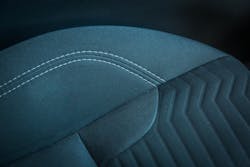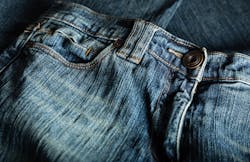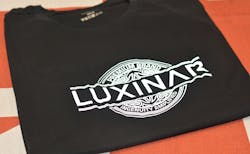Carbon dioxide lasers for the denim and textile industry
Carbon dioxide (CO2) lasers are employed in the manufacture of a wide variety of textiles, including natural and synthetic materials, in both the fashion and automotive industries.
Laser processing is flexible, allowing designs to be created and modified with ease; textures and designs can be applied to sheets of fabric or finished items, and the whole process is both repeatable and adaptable. Compared with traditional processing, lasers can save both time and money, increasing productivity, improving quality, and reducing environmental impact.
Within the fashion industry, items including clothing, buttons, shoes, and bags can be processed using lasers. The automotive industry uses the same lasers to process a range of fabrics for car interiors, including seats, seat belts, airbags, interior trim, and carpets (FIGURE 1).
Making your mark on denim
Lasers are becoming increasingly commonplace in the denim industry, where they are used to apply patterns and effects to jeans and other clothing (FIGURE 2). Laser processing is a sustainable solution, reducing water usage and eliminating the need for the harsh chemicals associated with traditional processes. Productivity is dramatically increased, as laser finishing is much faster than conventional methods.Luxinar’s first introduction to the jeans marking business dates back to 2002, when two of the company’s early customers realized that laser technology could be used to reproduce fading, patterning, and rips directly onto denim jeans. The early cooperation between these companies led to increasing interest in this type of process from a number of jeans labels, which recognized the market potential. Initial laser sales were at the 300 W power level, broadening to 100–450 W over the next few years as other companies explored similar solutions for their respective global markets.
Solutions were developed by a range of companies predominantly in southern Europe and in Turkey, where a number of fashion houses contracted out the processing and assembly of the finished garments.
As interest grew, manufacturers continued to develop increasingly sophisticated solutions for the industry, using higher powers and multi-laser systems to speed up their processing. With the industry looking to increase the level of process automation, and also conscious of the numerous environmental and health issues that were associated with the traditional methods of marking, the use of CO2 lasers increased rapidly.
Luxinar (Kingston upon Hull, England) now counts among its customers the world’s major suppliers to the jeans industry. Although the majority of systems continue to be manufactured in Europe, a number of solution providers have been established in Asia and South America in order to better serve the local requirements of the industry.
Luxinar CO2 laser sources are incorporated into the finishing stage of the jean-making process, allowing manufacturers to reduce both chemical and water use and the time taken to make faded, distressed, and ripped jeans. The finishing systems incorporating CO2 lasers from Luxinar transfer a grayscale design to the surface of the denim by varying the intensity of the focused laser beam as it scans rapidly across the garment. The laser beam selectively removes pigment from the fabric to create shading and intricate patterns without damaging the texture of the material. On the other hand, rips, holes, and scuffs can be created if desired, using the same laser to cut or weaken the material according to the customer’s design.
With Luxinar’s lasers, jean manufacturers can finish a pair of jeans every 90 seconds instead of 20 minutes; this represents a significant advantage for an industry faced with increased competition and a fast fashion cycle. By comparison, other surface-altering techniques such as stonewashing and bleaching pose problems such as nonreproducible designs, an inability to apply the design to different fabrics, and reduced fabric quality after processing, not to mention the toxic nature of the harsh chemicals needed.
Laser technology for the denim market
Denim marking requires the laser parameters, including power, mode, wavelength, and polarization, to be very stable. Luxinar has developed unique cavity and electrode designs to ensure the required level of stability and pulse-to-pulse consistency. For example, the simultaneous generation of the required mode quality, mode stability, and polarization are the consequences of a novel patented design.
While lower powers are still utilized in the industry, laser powers up to 650 W are now commonplace. Performance is only limited by the system’s software and the ability of scanner technology to cope with the higher speeds and increased power demands.
The OEM series from Luxinar is a popular choice for denim applications. This range of sealed CO2 lasers comes in three wavelengths—10.6, 10.25, and 9.3 µm. It has a high quality, round, symmetrical beam for high processing speeds and a short optical pulse with high peak power. This ensures optimum process quality and minimizes the heat-affected zone.
The technology is based on the well-proven slab principle, with no need for gas recirculation equipment such as vacuum pumps or pressure control systems. As gas exchange is unnecessary before 20,000 operational hours, the running, maintenance, and service costs are minimal. This results in the laser having a long lifetime and trouble-free operation throughout.
Transfer designs on T-shirts
Of course, the possibilities for CO2 laser processing are not limited to the denim industry—CO2 laser technology finds a host of innovative applications across the fashion industry.
For example, CO2 laser cutting machines can be used to create designs on heat transfer film, used to decorate T-shirts and other fabric garments (FIGURE 3). In this case, the laser is not used directly on the garment itself—instead, a type of laser-friendly transfer film is engraved using the laser, removing excess material and leaving only the required design intact. The design is then transferred to the garment using a heat transfer press. Fully engraving the film has the advantage that the transfer does not require “weeding” before use—this is the time-consuming process of removing small pieces of waste material from the design, which would be left by simply cutting the profile out. With an engraving process, all of the waste is removed by the laser, reducing the total process time significantly.Leather processing
Natural and synthetic leather materials are used in both the fashion and automotive industries, where they may be used to make shoes, bags, clothing, car seats, and interior trim for high-end vehicles. Lasers are involved from the very beginning of the leather production process, where they are used to mark traceability codes on the animal hides prior to tanning. Laser technology means that the processed leather can be cut at high speeds, and intricate designs can be created with ease. The laser produces a good finish, minimizes waste and offers tremendous flexibility. Lasers can be used for texturing as well as cutting, removing the surface of the leather to create a pattern or design. This may be purely decorative, or it may be functional—for example, texturing leather for non-slip shoe soles.
Luxinar continues to perfect its CO2 laser source technology in order to keep pace with the increasing demands of the textile industry—this is a never-ending process. With increasing requirements for consistent laser performance, along with the growing demands for high reliability in some of the world’s most hostile production environments, Luxinar strives to remain a leading provider of laser sources to the denim and textile industry.
Louise May | Senior Applications Engineer, Luxinar Ltd
Dr. Louise May is senior applications engineer at Luxinar (Kingston-Upon-Hull, England).


